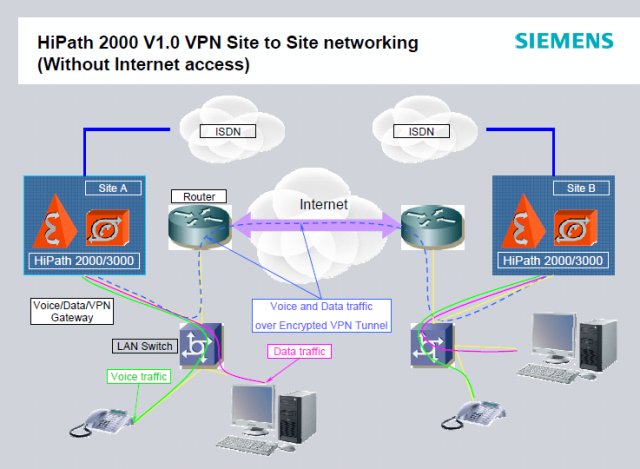Difference between revisions of "VPN Site-to-Site networking"
The Wiki of Unify contains information on clients and devices, communications systems and unified communications. - Unify GmbH & Co. KG is a Trademark Licensee of Siemens AG.
m (→VPN without normal Internet traffic: (Text modification)) |
m (heading 1 removed) |
||
| Line 4: | Line 4: | ||
__TOC__ | __TOC__ | ||
| − | |||
== VPN without normal Internet traffic == | == VPN without normal Internet traffic == | ||
Revision as of 18:37, 15 March 2007
Contents
VPN without normal Internet traffic
This Site-to-Site networking scenario lets enterprises to use:
- HiPath 2000 as Site-to-Site VPN gateway both for Voice and Data traffic.
- HiPath 2000 as a cost-effective gateway to route VoIP traffic by performing SIP and CorNet-IP IP trunking between sites over VPN trunk.
- HiPath 2000 as gateway to access enterprise resources and applications available on the company’s VPN networked sites.
Overview
Important informations
- Basic bandwidth reservation for Voice can be implemented on HiPath 2000 setting:
- Outgoing Bandwidth Control.
- B-Channels limitation.
- No external Firewall is required at site (HiPath 2000 features firewalling service).
- If, at some point, normal Internet traffic (like Web navigation, Mail server access, etc.) is required by the Customer, then Hipath 2000 VPN Site-to-Site networking implementation must be designed according to VPN with normal Internet traffic scenario. In that case:
- Customer need to ensure itself with additional ISP connection to Internet.
- Customer need to ensure additional devices/services like:
- Router, necessary to route LAN hosts normal traffic to Internet.
- Firewall, necessary to protect LAN hosts and implement DMZ at site.
- Proxy, necessary to implement Internet traffic policies.
VPN with normal Internet traffic
Overview
VPN Site-to-Site networking with normal Internet traffic Overview here
Important informations
- Normal Internet traffic completely separated from Voice traffic by means of second Internet connection to ISP:
- Voice quality over VPN is preserved from normal Internet traffic side effects (No Voice/Date traffic congestion, no burstly data traffic or high downstream can jam Voice connections).
- HiPath 2000 can manage VPN Bandwidth entirely (No Bandwith share with normal Internet traffic).
- HiPath 2000 lightweight processing power requirements handling and routing only Voice traffic over VPN Trunk.
- Routing/Security policies demanded to external Proxy/Firewall devices for normal unencrypted Internet traffic handling.
VPN with normal Internet traffic and QoS support
Overview
VPN Site-to-Site networking with normal Internet traffic and QoS support Overview here
Important informations
- The ISP must support QoS to ensure sufficient voice packet quality (According to specific SLA)
- HiPath 2000 as VPN Site-to-Site gateway to a single ISP access, used for both:
- Voice and Data traffic.
- Normal Internet traffic.
- HiPath 2000 as a cost-effective gateway to route:
- External additional Proxy/Firewall:
- must be capable to handle traffic carried by VPN transparently.
- offer high level of Security for normal unencrypted Internet traffic
- HiPath 2000 as gateway to access enterprise resources and applications available on the company’s VPN networked sites.
- The ISP access can be overloaded (Available bandwidth could be used by massive or bursty downloads) affecting Voice quality first (Bursty data traffic, high downstream can jam Voice connections).
- Operation of public servers on (DMZ) is only recommended QoS can be provided by ISP and access Router is able to support bandwidth control for both Voice and Data traffic.
- Not all ISPs are able nor have a suitable infrastructure ready to offer adequate/any QoS features on their Internet access.





